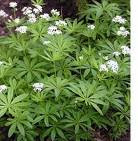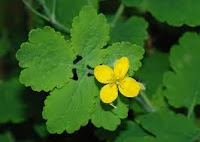As you might expect from its name, Sweet Woodruff is a sweet-smelling herb which was used in the Middle Ages as a strewing herb to sweeten the air with its aroma of new-mown hay and vanilla undertones. It was hung in garlands in churches as well as being strewn on the floor as it sweetened the air. It has been used in white wine for May Day celebrations particularly in Rhine wine in Germany
 It has been used in sachets to keep moths and other insects away from clothes and linen, in much the same way as lavender is used. It is useful dried and added to pot-pourris too with rose petals and cinnamon. Sweet woodruff has been used in pillows as well as to stuff mattresses as it is thought to promote peaceful slumber and cure insomnia. It is thought to have mild sedative actions and was tucked into the helmets of Mediaeval soldiers in the belief that it would bring victory in battle. This is rather like the broom of the British Plantagenet kings who adopted it as their emblem. The woodruff may have been used also because it was thought that it could lift the spirits, and it has mild anaesthetic properties.
It has been used in sachets to keep moths and other insects away from clothes and linen, in much the same way as lavender is used. It is useful dried and added to pot-pourris too with rose petals and cinnamon. Sweet woodruff has been used in pillows as well as to stuff mattresses as it is thought to promote peaceful slumber and cure insomnia. It is thought to have mild sedative actions and was tucked into the helmets of Mediaeval soldiers in the belief that it would bring victory in battle. This is rather like the broom of the British Plantagenet kings who adopted it as their emblem. The woodruff may have been used also because it was thought that it could lift the spirits, and it has mild anaesthetic properties. Culpeper believed that it helped with consumption, and could unblock obstructions in the liver and spleen, but remarked that it was “provocative to venery” which I suppose means that he considered it to be an aphrodisiac; this may explain another name for this plant ”Kiss Me Quick.”
 It is native to
It is native to The plant is said to have anti-coagulant properties, so can prevent blood clotting, and is used as a tonic tea and as a diuretic. However in large doses it can cause internal bleeding, so it is best used externally in compresses for varicose veins and phlebitis. In small quantities the tisane or infusion can ease stomach cramps, headaches and migraines, and soothes the digestive system, as it is believed to have anti-spasmodic and anti-inflammatory properties. The whole plant can be harvested before it flowers and dried for later use.
 Gerard, the 16th century herbalist wrote “It is reported to be put into wine to make a man merry, and to be good for the heart and liver; it prevaileth in wounds…” (another reason for soldiers having it in their helmets). The bruised leaves are said to be good to heal wounds, reduce swelling and cure boils.
Gerard, the 16th century herbalist wrote “It is reported to be put into wine to make a man merry, and to be good for the heart and liver; it prevaileth in wounds…” (another reason for soldiers having it in their helmets). The bruised leaves are said to be good to heal wounds, reduce swelling and cure boils. The Physicians of Myddfai recommended this mixture to be prepared after pneumonia had been “removed from the lungs”: -
“…let a medicine be prepared, by digesting the following herbs in wheat ale or red wine: madder, sharp dock, anise, agrimony, daisy, round birthwort, meadowsweet, yellow goat's beard, heath, water avens, woodruff, crake berry, the corn cockle, caraway, and such other herbs as will seem good to the physician.”
Then they had this remedy for fevers
 The mugwort, madder, meadow sweet, milfoil, hemp, red cabbage, and the tutsan, all these seven herbs enter into the composition of the medicine required. Whosoever obtains them all, will not languish long from a wounded lung, or need fear for his life. Any of the following herbs may be added thereto, butcher'sbroom, agrimony, dwarf elder, amphibious persicaria, centaury, round birth wort, field scabious, pepper mint, daisy, knap weed, roots of the red nettle, crake berry, St. John's wort, privet, wood betony, the roots of the yellow goat's beard, heath, water avens, woodruff, leaves of the earth nut, agrimony, wormwood, the bastard balm, small burdock, and the orpine.
The mugwort, madder, meadow sweet, milfoil, hemp, red cabbage, and the tutsan, all these seven herbs enter into the composition of the medicine required. Whosoever obtains them all, will not languish long from a wounded lung, or need fear for his life. Any of the following herbs may be added thereto, butcher'sbroom, agrimony, dwarf elder, amphibious persicaria, centaury, round birth wort, field scabious, pepper mint, daisy, knap weed, roots of the red nettle, crake berry, St. John's wort, privet, wood betony, the roots of the yellow goat's beard, heath, water avens, woodruff, leaves of the earth nut, agrimony, wormwood, the bastard balm, small burdock, and the orpine. Clearly the sweet woodruff has been used for centuries, but care should be taken with it as it can irritate sensitive skin, and it is better not to use it internally. If you do, don’t take too much of it as it can be harmful.

















































